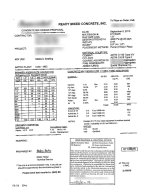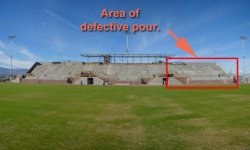orezok
Elite Member
There is very little concrete placed that meets the specifications of the mix when it left the plant.
You are probably correct for non critical concrete, but let me add my $0.02.
Attached is a copy of the design mix for this project. The concrete specified was 4,500 PSI mix with a W/C ratio of point 44. The in-truck slump is 6", but by the time it leaves the 30 meter pump it will drop to 3 1/2" to 4".
In order to be an approved mix, the concrete plant must submit no less than 10 test breaks from different batches by a certified testing lab indicating that it meets the design strength. This mix had 18 breaks averaging 4,800 PSI. The cylinders broken from my pour all averaged 5,500 to 6,500 PSI. We allow a maximum of one hour batch to place on public works projects.
The difference is probably that we require a full time batch plant inspector who sits in the weigh room with the weigh master to assure that the exact design mix is supplied.
I suspect that the home and garden contractors receive a mix that may not meet the design criteria.

